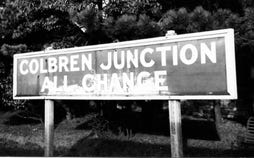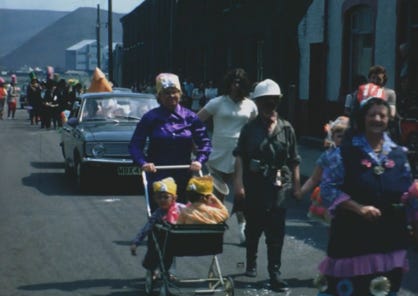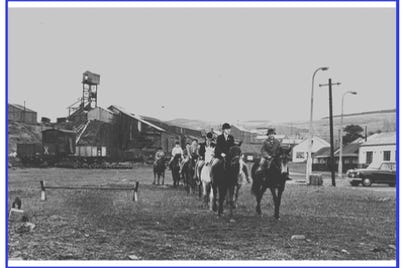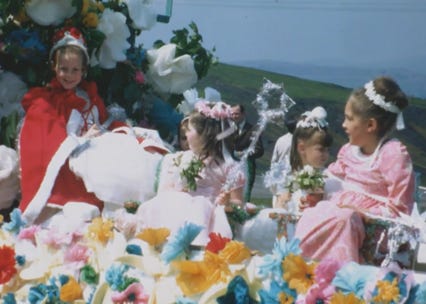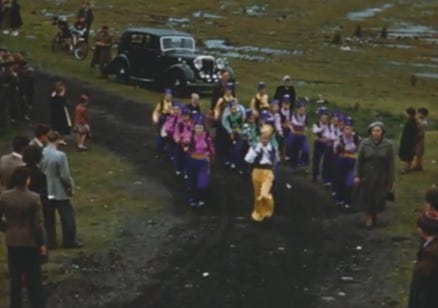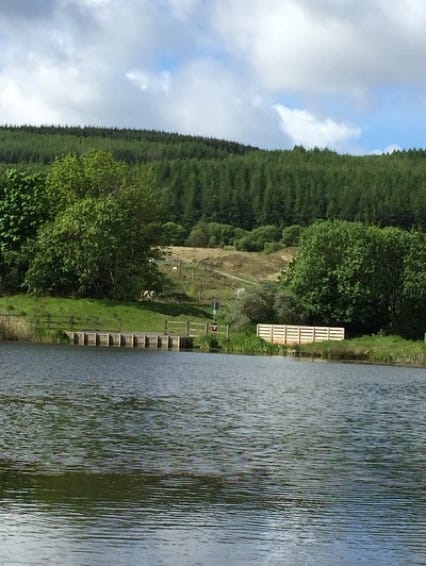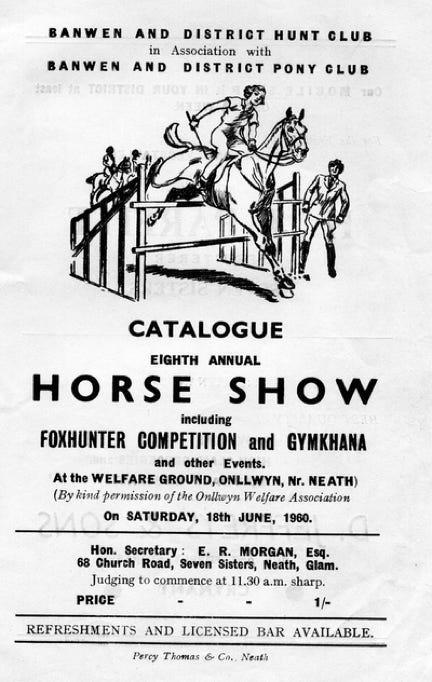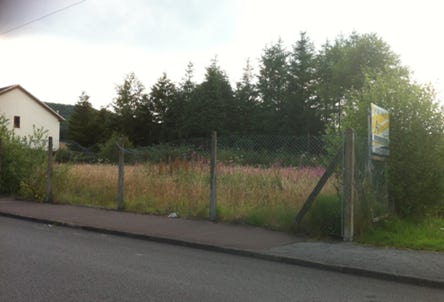“For the South Wales valleys, in which the union and its lodges were so often its big pulsating heart, the 1950s was still that faraway era before mass pit closures, bingo, social drinking and a television in every home. It was the golden era of the Miners’ Welfare Movement when many mining communities believed they were building little socialist islands by their own enthusiastic voluntary labour: a time of carefully tended bowling-greens, sparkling dance halls, shining new pit-head baths and Welfare Halls with cinema-scope screens.”
Francis & Smith, 1998
At Onllwyn, a football field, bowling green, tennis courts, children’s playground and paddling pool were established and maintained by miners’ subscriptions (and a large amount of voluntary building and maintenance work). Evans (1977) notes that in the 1940s-50s
“under the capable hands of T.J. Williams, an ex-miner, the bowling green was to be compared with any green in the surrounding area. The new walls and flower beds were appreciated by all who attended the grounds."
Later, after the colliery closures in the early 1960s, and the consequent decline in financial subscriptions,
“the sports ground was left unattended. Soon the straying sheep took possession and in a short space of time the bowling green was completely destroyed and the children’s corner a heap of rusted iron. Film shows no longer paid their way at the hall and had to be abandoned. Now the hall has been converted into a licensed bar, hoping in this way village welfare can still be served.” Evans, 1977
Thirty or so years later, in 1993, The Independent newspaper reported (article here) that the Ashgrove Inn at Coelbren held very popular themed events for men dressed up as American cowboys – it apparently provided an outlet for frustrated masculinity. For some years also, a Western-inspired sort of Welsh theme park operated near the village of Seven Sisters, “Gunsmoke City”, “you had to dress up as cowboy or Indian to go there” (Wales Online, Aug 2018). There was also a similar place in the Rhondda Valley, but as Finch (2008) comments it
“Didn’t work. Wild west in the wild west, like taking coals to Newcastle.”
But, at least for a while, did the values of the Old West somehow resonate better than chapel in by then thoroughly depressed south west Wales? Had homegrown Christianity run its course?
In 2014, the Coelbren Moriah Baptist Chapel was sold – to be re-developed as a house. The dwindling and elderly Welsh Baptists have accepted a time-share at Coelbren Church and instead of the hundreds attending Moriah sometimes three times on a Sunday in the early twentieth century, they are barely into double figures one hundred years later. Nantyffin chapel is now also slated for demolition due to its apparent instability and dangerous condition. The Ashgrove Inn at Coelbren has now also been sold, to be re-developed as an outdoor centre for a London private school (The Whitgift Foundation, Croydon).
Indeed, most people are now left with only homespun or piped-in entertainment as these two nominally opposing, but really rather mutually supporting institutions of chapel and pub decline and fade in public consciousness nowadays in equal measure. Coelbren House still faces the apparently remarkably thriving Prices Arms, though.
Perhaps the DOVE centre at Banwen – a women’s led community organisation forged in the crucible of the miner’s strike of 1984-85 - and still remarkably successful thirty years later - now fills in some of these gaps and provides a model for the future. It is housed appropriately in the old offices of the Banwen mines and links to that past society through its encouragement of community-based education and co-operative, skills-based activities: “trefn” in action. Indeed this area is no stranger to community-based actions of solidarity; in the 1930s it was one the largest fund-raisers supporting the republican effort in the Spanish Civil War and also contributed directly through the sacrifice of local men. The WW2 propaganda film “Silent Village”, an allegorical anti-fascist story based on the Nazi massacre at Lidice, Czechoslovakia. was filmed at Cwmgiedd, near Ystradgynlais, and features mainly local people, among them future South Wales NUM president Dai Francis, his mentor the communist organiser Dai Dan Evans and local historian Chris Evans.
There is now little or no trace of the mines at Banwen and Onllwyn. None of the physical infrastructure survives in any obvious form at all, and only keen archaeologists and geophysicists will find much evidence in the future. Only the now rather strangely isolated terrace of Roman Road, itself again now rather fading, gives an obviously important clue, as there would be absolutely no reason to built a row of houses there today, or in the last sixty years.
In and around, older locals can still pick out the occasional larger houses, which once housed colliery managers and clergymen, but that folk memory will disappear soon. We now see strange gaps in the settlements and constant “Land for Sale” signs where important community buildings once stood, built solidly enough in their time, but their uses now seemingly as ephemeral as the memories they created. Incongruities abound, such as a church built from corrugated iron in Dyffryn Cellwen; nearby, “Banwen Food and Wine” appears to stock and presumably sell very little of both.
The landscape appears transient and precarious and there is a dissonance in horses still grazing rather wildly in fields next to a rare newly built house, although these are not pit horses on a day off, and unlikely to have anything to do with today’s rather dispersed Banwen Miners’ Hunt, which itself has probably lost sight of its origins and now seems more attached to the Countryside Alliance. Banwen, as a drift mine, did not have “pit ponies”; the horses came above ground every day and were very well looked after.
The few constants in the landscape are some of the ancient farmsteads, named in reference to the Roman pass-through and while some still operate as farms, more are now private residences.
The author Peter Finch visited the area in the late 1990s with local historian Norman Burns and author George Brinley Evans.
"We reach the top of the village. It's taken us about five seconds. End house is boarded up, the one next to it has a large and dopy Alsatian spread out on the inside window ledge like a cat. Midday. Upstairs a vision in pink tracksuit, fag in hand, has just got up. A man in a cowboy hat comes out to start a car, fails, then immediately gives up. The rain comes in along Roman Road like an army of legionnaires. This was once Sarn Helen, clattering into Banwen from the fort at Coelbren then roaring out, up over Hirfynydd to the rest of the civilised world. Except that in those days there was no Banwen, nothing. Almost like now, not even a scrape in the ground.” (peterfinch.co.uk, Actually Banwen)
What celebration there is now of Banwen revolves around a rather wistful claim that Irish patron Saint Patrick was born in a hut - “ Tavarn-y-Banwen” - still a house in the bog there, impossible to prove but still not convincing mass tourism to flock in veneration. Had this been in Ireland, rich in relic, posterity, and moreover superstitious belief, this village would be wealthy beyond measure through the sale of guided visits and range of trinkets. But here, in rewinding twelve centuries in such a reductive way, seems a little desperate and again a sign of the lack of confidence facing many old mining communities. While every colliery village cannot - and should not - have a museum on the scale of Big Pit at Blaenavon or the Rhondda Heritage Park, the fact that there is little recognition of the area’s industrial - and social - legacy appears forgetful. At least at Seven Sisters they have stuck a couple of the winding wheels in the ground in faint recognition of what once were the literal powerhouses of the village. At Banwen there seems to have been an indecent haste to remove what seem to have been embarrassing reminders of the exploitation of both man and nature; a removal of what has anyway often been described as a fundamentally unnatural process.
Thus we again return to the paradox that while this work was filthy, dangerous and woefully underpaid, it did create vibrant communities that easily supported many variants of sporting, cultural and religious activities. Local shops and small businesses prospered but are now nowhere to be seen. In the 1960s, declining employment reduced the financial contribution local NUM lodges could make to once rich educational, social and cultural life: way back in the 1930s, some ascetics had complained that the adoption of cinema in many Miners’ Institutes was diverting the people from their main purpose; now they bemoaned the mutation of of the Welfare Halls into mere vessels for bingo and drinking (Francis & Smith, 1980). Now they would be glad of any of that business regularly. Despite all that, community continued. The carnival, a cleverly-designed excuse for all ages to forget themselves for a day, shows aspects of a happy and vibrant community in the films local baker, John Williams, took in the late 1960-70s. Almost deliberately defiant, next to the coal black we see vibrant uniforms tip-toeing over the mud, as if, just for a day, they were on a bigger stage than than the Onllwyn coal-scape.
Of course, having built these communities, coal’s legacy still wears on because while industry’s loyalties are fickle, people stay. Very early on, coal had turned the original rural population into an urban one, and diverted its affiliations, priorities and motivations from the pastoral Welsh to the urban, industrial and English. The people are now not equipped to participate in a rural environment they don’t really understand, from which landscape their now airbrushed industrial creator has now moved on, and which itself has very little to offer anyway in modern agricultural terms. The new projects are large scale and low employment – wind farms and rally driving, both well suited to the high plateau. Thus, the villages limp on; sometimes now populated with thoroughly atomised younger people travelling out of the area to work; more often, we return to where we started at the beginning of the nineteenth century, a form of subsistence, now sanitised with statistics, officially dressed up in the modern terms of the Welsh Index of Multiple Deprivation. In 2009, Neath Port Talbot Borough Council mechanically reported that Onllwyn fell within the 25% least deprived areas in Wales – in terms of physical environment. Air quality and noise pollution, unsurprisingly given the lack of activity, was not a problem and there was a Site of Special Scientific Interest to improve its ratings. When it came to income, employment and access to services, Onllwyn was in the top 25% most deprived wards in Wales.
